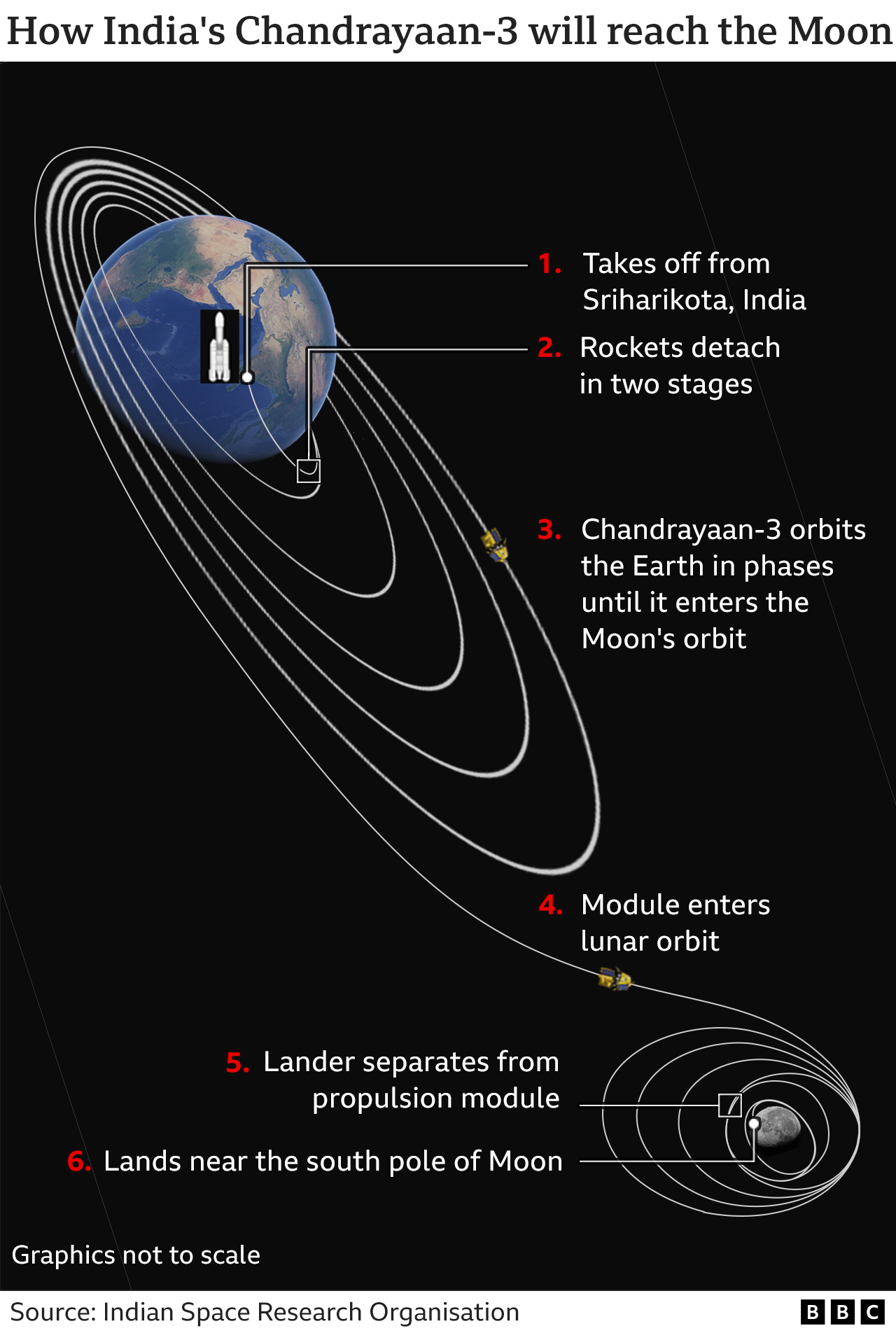India's third lunar mission is inching closer to the Moon's little-explored south pole where it aims to set down a lander and rover on 23 August.
On Thursday, the lander detached from the propulsion module, which carried it close to the Moon, beginning its last phase of the mission.
Chandrayaan-3, however, may not be the first to land on the south pole if it's beaten by a new Russian mission.
Luna-25, launched last week, is expected to land a day or two earlier.
If the Russian spacecraft - its first Moon mission since 1976 comes in nearly half a century when Russia was part of the Soviet Union - is successful in making a soft landing on 21st or 22nd August as planned, Chandrayaan-3 will have to settle for being a close second.
India, however, will still be only the fourth country to achieve a soft landing on the Moon after the US, the former Soviet Union and China.
Russia launched Luna-25 on 10 August, but propelled by the much more powerful Soyuz rocket, it escaped the Earth's gravity in no time and reached lunar orbit on Wednesday, the Russian space agency Roscosmos announced.
Chandrayaan-3 was launched on 14 July, but it went around the Earth a few times before entering the lunar orbit on 5 August. The spacecraft has been orbiting the Moon since then, while preparing for the landing.
The two missions aiming for the Moon are being described by many as a "mini space race".
Isro, however, told the BBC it's not a race and the two nations will have a new 'meeting point' on the Moon.
"Isro has never been in any race right from the day one of its inception in 1960s," an Isro spokesman told me.
"We planned the mission based on the readiness of the spacecraft and the available technical window to reach the far side of the Moon. Luna-25 is also a mission planned long time ago. They also must have some technical considerations, which we don't know precisely," he said.

Chandrayaan-3, the third in India's programme of lunar exploration, is expected to build on the success of its earlier Moon missions.
It comes 13 years after the country's first Moon mission in 2008, which discovered the presence of water molecules on the parched lunar surface and established that the Moon has an atmosphere during daytime.
Chandrayaan-2 - which also comprised an orbiter, a lander and a rover - was launched in July 2019 but it was only partially successful. Its orbiter continues to circle and study the Moon even today, but the lander-rover failed to make a soft landing and crashed during touchdown.
Isro chief Sreedhara Panicker Somanath has said India's space agency had carefully studied the data from its crash and carried out simulation exercises to fix the glitches in Chandrayaan-3, which weighs 3,900kg and cost 6.1bn rupees ($75m; £58m).
The lander module (called Vikram, after the founder of Isro) weighs about 1,500kg and carries within its belly the 26kg rover which is named Pragyaan, the Sanskrit word for wisdom.
Once the craft entered the Moon's orbit, scientists gradually reduced the rocket's speed to bring it to a point which will allow a soft landing for Vikram.
Chief of India's first Moon mission Mylswamy Annadurai told the BBC that after Thursday's separation from the propulsion module, the lander module will do two manoeuvres over the next few days, getting closer to the Moon with each one, and will reach an orbit of 30km by 100km a day before it lands.
Once it lands, he says, it will take a few hours for the dust to settle after which the six-wheeled rover will crawl out and roam around the rocks and craters on the Moon's surface, gathering crucial data and images to be sent back to Earth for analysis.
The rover is carrying instruments which will focus on finding out about the physical characteristics of the surface of the Moon, the atmosphere close to the surface and the tectonic activity to study what goes on below the surface.
The south pole of the Moon is still largely unexplored - the surface area that remains in shadow there is much larger than that of the Moon's north pole, and scientists say it means there is a possibility of water in areas that are permanently shadowed.
One of the major goals of both Chandrayaan-3 and Luna-25 is to hunt for water ice which, scientists say, could support human habitation on the Moon in future. It could also be used for supplying propellant for spacecraft headed to Mars and other distant destinations.



You must be logged in to post a comment.